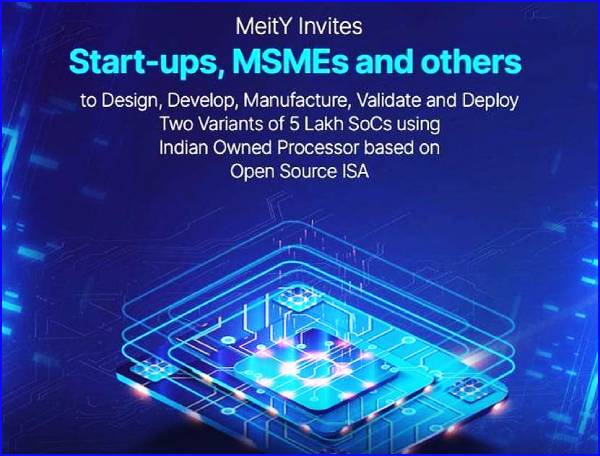
New Delhi,September 12, 2022: In an initiative of far-reaching consequences,India’s Defence Ministry has put its money where its mouth is: it hastranslatedbuzzwords like Atmanirbhar Bharat into practical action by volunteering tohelm the production of 5 lakh semiconductor chipsdivided across two designs, provided they are based on an indigenousdesign andIndian Intellectual Property (IP).
It has committed to consume 10 percent of the microchips so produced –that is 50,000 units—in a military role, leaving the makers to sell the rest in the civilian market. This demonstratesshrewd realization that a military market alone, can never enthuse the industryand thehigherperformance criteria ( andconsequent makingcost) demanded byarmed forces applications – what are called MILSTD or military standard – need to be offset bylargercivilian consumer and enterprise markets.
In a Sunday afternoon posting on his Facebook Page, Defence Secretary Dr Ajay Kumar has shared a link to the Ministry of Electronics and IT site which carries a copy of the September 7 Tender Document.
Writes Dr Kumar: “A great initiative towards Cyber Secure India!! Development of Indian microprocessor based chips would be historic development in the history of cyber security of Digital India. No more fear of embedded backdoors or malware vulnerabilities in chips which we use for our equipment.”
He adds: “…Once developed India could be source of secure chips in the global electronics supply chain. Therefore, this small step is expected to open many new doors in the future.”
The 105-page Request for Proposal emphasises the central mantra that has motivated government:
"The core of the SoCs is to be based on processors designed and owned by Indian entities, designed based on ‘Open Source’ ISA. In addition to design, development and packaging in India, the major design IPs ie Processor, Secure Boot and Security IPs of such processors are to be owned by Indian entities.”
SoC stands for System-on-a-Chip ( SoC), jargon for a single slab of silicon or some other semiconductor material that integrates all components of a computer or other specialist electronic system. The insistence on Open Source will make it easy for a wider community of developers to build newer applications exploiting the basic chip. The tender effectively rules out global chip makers submitting their own proprietary commercial products. The Ministry’s insistence that the “processors must be “designed and owned by Indian entities” is the biggest vote of confidence till date in the inherent capability of Indian engineers to deliver indigenous intellectual property to meet the stringent environmental and performance requirements of the military.
---------------------------------------------------------------------------------
This story has appeared in Swarajyamag on September 11
---------------------------------------------------------------------------------
Typically Military Standard devices must meet severe shock and vibration standards and function in all environments from desert to icy heights. At the minimum in India, this covers a temperature range of minus 40 degrees Celsius to plus 55 degrees.
The statement of intent also reveals tacit acceptance that at present India does not have indigenous fabs or semiconductor fabrication facilities where chips to the currently achievable standards of density can be manufactured. Hence it insists on “design, development and packaging in India” but does not include manufacture.This opens the possibility that the winning applicants would be free – at least to start with – to use a silicon foundry outside India, but then package the final products in India. This also neatly dovetails with the way the indigenous semiconductor manufacture roadmap is being laid out: even new aspirants like Tata Electronics are said to be scouting for partners to set up packaging units of microchips first, before entering the foundry business.
Hitherto, the armed forces have been using inhouse labs within the Defence Research and Development Organisation ( DRDO) basedin Hyderabad and Bengaluru to design its strategic semiconductor device requirements and has been using the Semi Conductor Laboratory ( SCL) in Chandigarh under the Department of Space as a manufacturing base. However SCL is not equipped to manufacture to current commercial standards that are in the 5-7 nanometer range. ( one nanometer is one-billionth of a meter).
However there are many applications that do not require this level of component density – and for starters there are already two academic agencies in India who have already created a wholly Indian microchip:
That may all change now: If Shakti or Ajit can be used to create what the new tender called BSC-1 and BSC-2 ( for Bharat Secure Chip) and meet their application requirements, this will provide a big head start for any one hoping to qualify for the opportunity offered by the Defence Ministry.
In another pragmatic step, the government has offered to provide some monetary Deployment Linked Incentives (DLI) and has even offered to provide 20% of this in advance.
The tender says it expects the first chip to be ready in 3 and a half years and the second in four years. A subsequent tender would address the making two more advanced Systems on a Chip.
It remains to see what level of interest the Defence Challenge will evoke. But it can be fairly said, the government has in this instance, translated words into action – and challenged the electronics industry to respond.